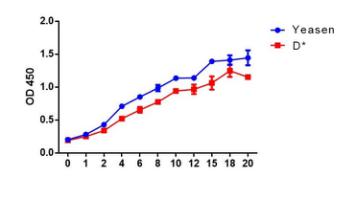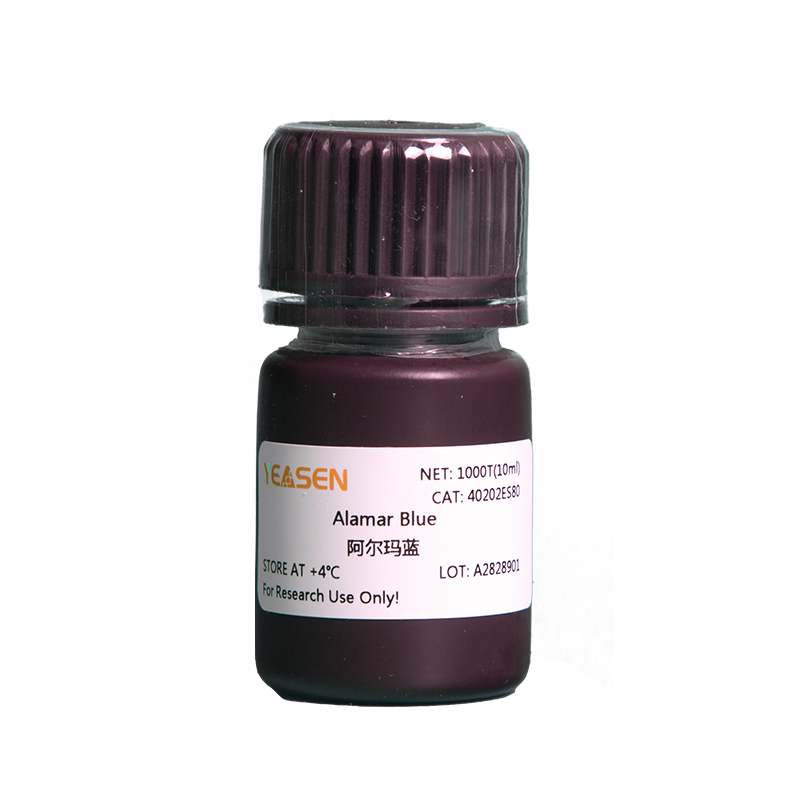Cell Counting Kit-8简称CCK-8试剂盒,是一种基于WST-8(化学名:2-(2-甲氧基-4-硝苯基)-3-(4-硝苯基)-5-(2,4-二磺基苯)-2H-四唑单钠盐)的广泛应用于细胞增殖和细胞毒性的快速高灵敏度检测试剂盒。
WST-8属于MTT的升级产品,工作原理为:在电子耦合试剂存在的情况下,可以被线粒体内的脱氢酶还原生成高度水溶性的橙黄色的甲臜产物(formazan)。颜色的深浅与细胞的增殖成正比,与细胞毒性成反比。使用酶标仪在450nm波长处测定OD值,间接反映活细胞数量。
CCK-8法应用非常广泛,如药物筛选、细胞增殖测定、细胞毒性测定、肿瘤药敏试验以及生物因子的活性检测等。
操作简单:产品本身是液体,即开即用;甲臜产物是水溶性的,不需要用有机溶剂溶解。
灵敏度高:线性范围广,灵敏度高,重复性好。
细胞毒性低:细胞毒性非常低,对后续实验没有影响。
稳定性好:培养液中酚红和血清的存在不会对检测造成影响。
应用性广:可用于大规模、高通量样品检测。
同类产品性能比较:

细胞类型:293T人胚肾细胞;培养基:10% FBS 高糖DMEM培养基
孵育时间:3h;细胞数目:1000
引用已发表文献数据:
 |  |
| GIST-T1细胞增殖检测CRTL为空白对照组,Lv-shNC为阴性干扰组,Lv-shOrai1为Orai1敲除组 | ROS17/2.8细胞增殖检测WT为野生型,KO为BK基因敲除组 |
 |  |
| rMSCs细胞活性检测在2.5,5,10,20ug/mL的浓度 G/SWCNT hybrids, G, and SWCNTs处理下的细胞活性检测 | rMSCs细胞增殖检测G/SWCNT hybrids 在2.5,5,10,20ug/mL的浓度下处理1,3和7天细胞活性检测 |
 |  |
| Huh6细胞干扰EZH2基因和阴性对照组细胞活性检测 | HepG2细胞干扰EZH2基因和阴性对照组细胞活性检测 |
 |  |
| GIST-T1 细胞活性检测分别在2-APB 不同浓度0, 50, 100, and 150µM处理下的细胞活力检测 | GIST-T1 细胞活性检测分别在SKF-96365不同浓度下0, 0.5, 1.0, and 1.5µM处理下胞活力检测 |
冰袋运输,-25~-15“C避光干燥保存,有效期2年。
Q:CCK-8 的保存和稳定性如何?
A:CCK-8 稳定性高,避光条件-20℃有效期 2 年,4℃有效期 1 年。经常使用建议 4℃ 保存,避免反复冻融。CCK 正常颜色为粉红色,若颜色发生明显偏差,质量可能有发生变化。
Q:CCK-8 的细胞毒性如何?
A:CCK-8 毒性非常低,因此 CCK-8 检测完后相同的细胞还能用于其它细胞增殖检测如结晶紫染色法,中性红染色法或 DNA 荧光染色法。
Q:CCK-8 会对活细胞进行染色吗?
A:不会,首先 WST-8 不会进入细胞染色,整个显色反应都是在培养体系中进行的。另外 WST 和 WST-8 甲臜都属于高度水溶性组分,反应结束更换新的培养液,即可清除外源组分。因为 CCK-8 是基于 WST-8 能够被线粒体内的脱氢酶还原生成高度水溶性的橙黄色甲臜产物(Formazan)的原理研制开发的,因而不会对细胞进行染色。
Q:培养基的本底颜色如酚红会不会影响细胞活性的检测呢?
A:不会的,培养基中酚红的吸光度可以在计算时,通过扣除空白孔中本底的吸光度而消去,因此不会对检测造成影响。
Q:在加入 CCK-8 时可否不更换培养基?
A:一般情况下可以不更换培养基。但是如果培养基里有氧化还原性物质的话,有可能会产生误差,必须更换其它培养基。
Q:在实验中OD 值太高或者太低,怎么解决?
A:太高可以缩短加入CCK-8 后的培养时间。例如:可以把加入CCK-8 试剂后的培养时间由 2 小时缩短为 1 小时。此外,可适当减少细胞的数量。太低可以采取 2 个办法: 1、适当增加细胞数量 2、延长加入CCK-8 试剂后的反应时间。
Q:哪些物质会影响 CCK-8 的实验测定结果?
A:当培养体系内含有还原性物质存在时会还原 WST-8,从而使 OD 值增加;当有氧化性物质存在时会抑制还原反应进而使 OD 值减小。
Q:做细胞毒性实验,我的细胞都死了,为什么我加入CCK8试剂后检测的OD值和对照组OD值差不多?
A:①细胞凋亡或者死亡之后乳酸脱氢酶被释放到细胞培养液中,可以长期存在,从而导致检测的OD值偏大。再次说明细胞的活性和OD值并不能完全划等号。建议客户在加入CCK8的时候更换新的培养基,确保得到准确的结果。
②加入细胞中的检测药物是还原性的,从而导致OD值偏高。建议加入CCK8的时候更换新的培养基。
Q:对照组(培养基+CCK8)的值很高,是为什么呢?
A:可以测一下培养基是否含有氧化还原物质,可能是培养基中的物质引起的。
Q: 细胞不贴壁可以测活性吗?预培养是必须的吗?
A: 需要预培养,如果要向保持细胞的最好状态,建议预培养细胞。如果不做细胞预培养 ,细胞内的脱氢酶可能会不稳定。若不做细胞预培养,需在做标准曲线和检测时需要统一检测条件。
Q: CCK-8能否检测细菌细胞?
A: 可以检测大肠杆菌,但不能检测酵母细胞。向100μl E.coli培养液中加入10μl CCK-8溶液,并培养1-4个小时或过夜。
- Qian X, Yi W, Yan W, et al. Cryo-Shocked Tumor-Reprogrammed Sonosensitive Antigen-Presenting Cells Improving Sonoimmunotherapy via T Cells and NK Cells Immunity. Adv Mater. Published online February 16, 2025. doi:10.1002/adma.202413289 (IF:27.4)
- Yao C, Ni Z, Gong C, et al. Rocaglamide enhances NK cell-mediated killing of non-small cell lung cancer cells by inhibiting autophagy[J]. Autophagy, 2018, 14(10): 1831-1844. IF(11.1)
- X Fan, H Cheng, et al. Incorporation of Polycaprolactone to Cyclodextrin-Based Nanocarrier for Potent Gene Delivery. Macromolecular materials and engineering, Volume303, Issue9 ,September 2018.IF(2.777)
- Cheng H, Fan X, et al. Cyclodextrin-Based Star-Like Amphiphilic Cationic Polymer as a Potential Pharmaceutical Carrier in Macrophages. Macromol Rapid Commun. 2018 May 28. IF(4.441)
- Ma Q, Zhang Y, Liang H, et al. EMP3, which is regulated by miR-663a, suppresses gallbladder cancer progression via interference with the MAPK/ERK pathway[J]. Cancer letters, 2018, 430: 97-108.IF(6.491)
- Liu Y, Pan Y F, Xue Y, et al. uPAR promotes tumor-like biologic behaviors of fibroblast-like synoviocytes through PI3K/Akt signaling pathway in patients with rheumatoid arthritis[J]. Cellular & molecular immunology, 2018, 15(2): 171. IF(7.551)
- Shen, C.T., et al., Metformin reduces glycometabolism of papillary thyroid carcinoma in vitro and in vivo. J Mol Endocrinol, 2017. 58(1): p. 15-23.IF(3.297)
- Jiang, J.Z., et al., Metabolic-induced cytotoxicity of diosbulbin B in CYP3A4-expressing cells. Toxicol In Vitro, 2017. 38: p. 59-66.IF(3.105)
- Du Z, et al., MicroRNA31-NDRG3 regulation axes are essential for hepatocellular carcinoma survival and drug resistance. Cancer Biomark, 2017.IF(2.392)
- Li, X., et al., Placental growth factor silencing ameliorates liver fibrosis and angiogenesis and inhibits activation of hepatic stellate cells in a murine model of chronic liver disease. J Cell Mol Med, 2017.(4.302)
- Liu, S., et al., Macrophage infiltration of electrospun polyester fibers. Biomater Sci, 2017.IF(5.831)
- Shi, G., et al., Sox9 facilitates proliferation, differentiation and lipogenesis in primary cultured human sebocytes. J Dermatol Sci, 2017. 85(1): p. 44-50.IF(3.675)
- Liu, Y., et al., uPAR promotes tumor-like biologic behaviors of fibroblast-like synoviocytes through PI3K/Akt signaling pathway in patients with rheumatoid arthritis. Cell Mol Immunol, 2017.IF(7.551)
- Zhang, S., J. Yin and J. Zhong, Chaetocin reactivates the lytic replication of Epstein-Barr virus from latency via reactive oxygen species. Sci China Life Sci, 2017. 60(1): p. 66-71.IF(3.085)
- Yang, Q.L., et al., Sweroside ameliorates alpha-naphthylisothiocyanate-induced cholestatic liver injury in mice by regulating bile acids and suppressing pro-inflammatory responses. Acta Pharmacol Sin, 2016. 37(9): p. 1218-28.IF(3.562)
- Wei, W.J., et al., Propranolol sensitizes thyroid cancer cells to cytotoxic effect of vemurafenib. Oncol Rep, 2016. 36(3): p. 1576-84.IF(2.976)
- Yang, Y., et al., Human CIK Cells Loaded with Au Nanorods as a Theranostic Platform for Targeted Photoacoustic Imaging and Enhanced Immunotherapy and Photothermal Therapy. Nanoscale Res Lett, 2016. 11(1): p. 285.IF(3.125)
- Liu, T., et al., Slowly Delivered Icariin/Allogeneic Bone Marrow-Derived Mesenchymal Stem Cells to Promote the Healing of Calvarial Critical-Size Bone Defects. Stem Cells Int, 2016. 2016: p. 1416047.IF(3.989)
- Zhou, Y., et al., Synergistic anti-liver fibrosis actions of total astragalus saponins and glycyrrhizic acid via TGF-beta1/Smads signaling pathway modulation. J Ethnopharmacol, 2016. 190: p. 83-90.IF(3.115)
- Li, W., et al., MicroRNA-495 regulates starvation-induced autophagy by targeting ATG3. FEBS Lett, 2016. 590(6): p. 726-38.IF(2.999)
- Yang, F., et al., Waltonitone inhibits proliferation of hepatoma cells and tumorigenesis via FXR-miR-22-CCNA2 signaling pathway. Oncotarget, 2016. 7(46): p. 75165-75175.IF(2.656)
- Li, S., et al., DNA Cleavage and Condensation Activities of Mono- and Binuclear Hybrid Complexes and Regulation by Graphene Oxide. Molecules, 2016. 21(7).IF(3.098)
- Li, Z.T., et al., Outer membrane vesicles isolated from two clinical Acinetobacter baumannii strains exhibit different toxicity and proteome characteristics. Microb Pathog, 2015. 81: p. 46-52.IF(2.332)
- Xiao, K., et al., Inactivation of BLU is associated with methylation of Sp1-binding site of BLU promoter in gastric cancer. Int J Oncol, 2015. 47(2): p. 621-31.IF(3.333)
- Sun, Y.P., et al., Synovium fragment-derived cells exhibit characteristics similar to those of dissociated multipotent cells in synovial fluid of the temporomandibular joint. PLoS One, 2014. 9(7): p. e101896.IF(2.766)
- Qiao, N., et al., Haemolytic activity and adjuvant effect of soyasaponins and some of their derivatives on the immune responses to ovalbumin in mice. Int Immunopharmacol, 2014. 18(2): p. 333-9.IF(3.118)





